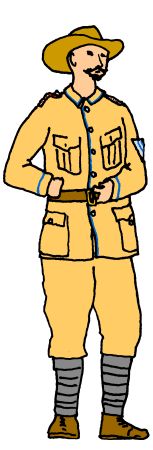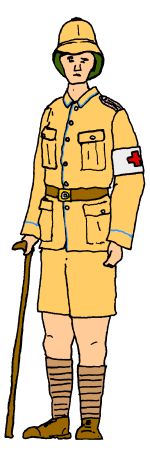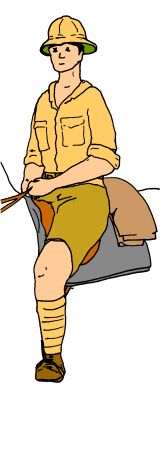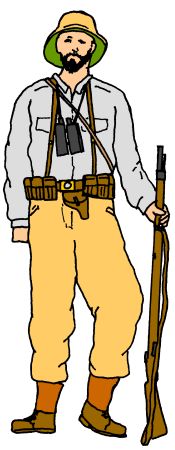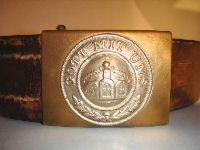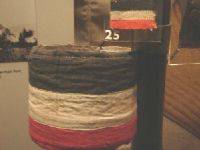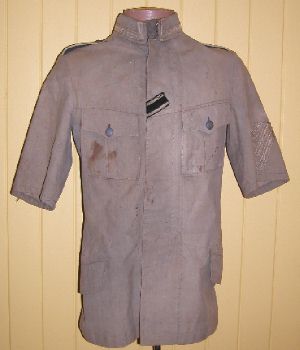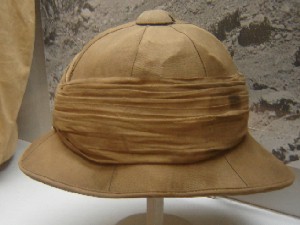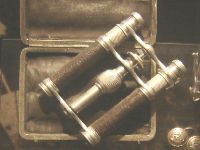|
Uniforms of the German Officers and
NCOs of the East African Schutztruppe in the First World War
German Officers and NCOs started off the war very uniformly
dressed in 1896 Schutztruppe Khaki
Uniforms piped in blue.
Khaki Tropical Helmets were usually worn, with
grey field caps (with white hatbands and piping for East Africa) sometimes replacing them.
Occasionally East African officers and NCOs wore the grey
Südwester Hat again with hatband
and edging in white.
Most
Peacetime Uniforms, such as the grey home uniform and white tropical
uniform were not worn in wartime. Old white
Tropical Helmets were worn
with khaki covers. Elaborate insignia such as medals, parade
aiguillettes, marksmanship awards and musicians nests were removed from
uniforms. Rank Insignia for Officers
and for NCOs was retained but again
not always worn. With the absence of any uniform item to show which side
they were on, some German troops wore brassards in the imperial colours.
Often the only insignia worn was the pre-war Schutztruppe belt buckle.
As the war dragged on with no new supplies
of uniforms, uniform regulations had to be relaxed (the Schutztruppe 1916
uniform regulations specifically state that uniforms in the
colonies will not
be affected by new rules. This is somewhat ironic as the Colonial
Office in Berlin authorising new regulations had little chance of issuing new
uniforms in East Africa and all other colonies had surrendered
by this date). Some clothing in East Africa was modified, improvised or
obtained from private sources. Civilian white shirts were dyed with
tea, coffee or local plant mixtures to different shades of light brown
to khaki. This improvisation was especially the case
with new officers and NCOs from
Reservists and Naval
Officers and Sailors who had never owned the original pre-war
Schutztruppe uniform. Captured British, Portuguese and Belgian uniforms
and headdress were also commonly worn, stripped of enemy insignia.
Short trousers were not issued to the
Schutztruppe before the war and yet many photos show them being worn
during the war. Some of these may have been captured from British stocks
but most were probably old Schutztruppe trousers cut down to size.
Likewise tunic sleeves were sometimes cut down or tunics were simply not
worn and were replaced by lightweight shirts.
Various camouflage efforts were made, foliage was worn in the headdress.
One passage in "Blockade and Jungle" by
Christen P Christensen describes a scene where one German narrowly
avoids shooting another German by mistake and only recognises the fact
that he is friend rather than foe by the fact that his target has a long
beard- the British were usually clean shaven while the Germans allowed
their beards to grow on campaign, probably mostly due to a shortage of
razors. The Portuguese Official History of
the War says that German troops often blackened their faces to aid in
camouflage and make them
stand out from their askaris less.
Equipment and weapons were likewise
either of pre-war, improvised or captured stocks, although the two
blockade running ships "Reubens" and "Marie" also brought some new
German weapons to the colony.
The illustrations above are fairly typical of the appearance of German
Schutztruppe officers and NCOs in the later stages of the war.
| |
|
|
| |
The Illustrations Figure 1
is based on a photograph of an NCO of the 21. Feldkompagnie
of the East African Schutztruppe taken on campaign in the later
years of the First World War. He wears his original
1896 khaki uniform with blue piping, white metal buttons bearing the
imperial crown, shoulder straps of twisted cords in the imperial colours
and NCO chevrons in white metallic lace on the upper left arm. His
trousers are matching khaki and are probably piped down the outside in
blue. They are tucked into grey puttees and brown leather boots. His
equipment is a Schutztruppe brown leather belt and NCOs belt buckle. He is
dressed much as he would have been before the war but wears a non-regulation
slouch hat, which may be privately purchased or possibly captured (it
looks very similar to the Portuguese army slouch hat).
Figure 2 is based on a photograph
of a Medical Officer of the 9. Feldkompagnie of the East African
Schutztruppe taken on campaign in the later years of the First
World War. He wears a
khaki Schutztruppe tropical helmet
of the old tall 1896 type. The officers cord and imperial cockades
from these helmets were often lost or removed on campaign. He still
wears his original Schutztruppe blue piped khaki tunic with an other
ranks belt and buckle (see right) but his shorts are non-regulation,
either cut down from full length Schutztruppe trousers or possibly captured British items. The khaki puttees commonly worn by
the Schutztruppe later in the war were again from captured or improvised
stocks. Being a doctor or medic he wears a white red cross armband to
identify him as a non combatant.
Figure 3 is based on a
late wartime photograph of Oberleutnant zur See Wenig of the 2. Batterie of the East African Schutztruppe taken
on campaign in the later years of the First World War. Wenig had been a naval
gunnery officer on the SMS Königsberg
and then commanded the 2nd Schutztruppe Artillery Battery on land. It should be
noted that former naval personnel serving in the Schutztruppe during the First
World War kept their naval rank titles.
Like most former
naval crew later in the war, he has discarded his naval uniform entirely. He wears a captured British Wolseley
tropical helmet, an unidentifiable khaki shirt with no rank
distinctions and corduroy shorts. His shorts have been preserved and are
photographed in
"The
German Colonial
Troops 1889-1918" by
J Kraus and T Müller.
They are dark khaki, similar to the shade often issued to the
South West African
Schutztruppe. They may have been cut down from a pair of
officers riding breeches. In the original photograph upon which
this illustration is based his puttees can been seen to be quite
roughly made, and are probably cut from strips of khaki cloth or
blanket. His "boot" is in fact a homemade prosthetic foot which
he made himself after being wounded in action. It should be
noted that like many German and Entente European officers in the
East African campaign he wears nothing to clearly identify
himself as belonging to either side.
The use of horses in East Africa was very limited due to their susceptibility to
diseases carried by the tsetse fly especially in the south of the colony. Officers were
sometimes mounted (often on
mules or small
tough ponies) at the head of columns of askaris.
| |
Richard Wenig
had been a gunnery officer as a Leutnant Zur See on the SMS Königsberg. When the crew of the
Königsberg were incorporated into the Schutztruppe Wenig went on to command
von Lettow-Vorbeck's artillery including the salvaged guns from the
Königsberg. Wenig lost his left foot in action around the Rufiji Delta on 11th
July 1915, but
was promoted to Oberleutnant zur See on 23rd March 1916 and continued in service right up to the end of the war (being one of the last 30
officers to surrender in November 1918) with a prosthetic foot he made himself.
This may explain
why he is one of the few mounted officers seen late in the war. After the war Wenig wrote a book called "Kriegs-Safari"
based on his experiences during the war in East Africa.
Recommended External Link - Discussion on
DOA Schutztruppe Officers at the Axis History Forum |
Figure 4 is based on a
photograph
of a Schutztruppe NCO taken on campaign in the later years of the
First World War.
He wears a khaki tropical helmet, which may be the Schutztruppe new
lower type authorised in 1913 or possibly a
private purchase item. It has no cockades or NCO cords. He wears a white shirt,
which again may be issue or private purchase in origin. It may also
have been dyed a slightly darker colour. He wears Schutztruppe khaki trousers
(possibly piped in blue). They are tucked into non-regulation
gaiters and short ankle boots.
Like many officers and NCOs in the field he finds binoculars
very useful and like most things for the Germans in East Africa
they were hard to come by, so captured and civilian items were
used alongside issue stocks. The Imperial War Museum in London
even has a pair of opera glasses captured from the German forces
in East Africa during the First World War. His equipment
consists of 1909 ammunition pouches on shoulder straps and a
brown leather belt held at the front with a Schutztruppe NCOs
belt buckle. This is the only clue as to his rank, even then it
is not certain as many officer also wore the less conspicuous
NCO belt in action. He is armed with a K98 carbine and a pistol.
The small size of the holster suggests this is again a privately
purchased item rather than the larger Reichsrevolver 1883 or
Luger 1908 issue weapons. As with the previous
figure, he
wears very little to distinguish him as belonging either side. |
|
| |
|
|
Period Photographs
All the following
photographs
show German officers, NCOs and other ranks (whose rank is mostly
indistinguishable), during the later period of the First World War. They
all wear a mixture of Schutztruppe and naval issue uniforms and civilian or
captured attire. Many have the tall 1891 Schutztruppe topical helmet,
usually covered in khaki, others have the later lower 1913 Schutztruppe helmet,
some have captured helmets and some have locally acquired slouch hats.
Some of the uniforms are Schutztruppe 1896 issue in need of repairs,
some are askari pocketless tunics, others are locally made or captured
items while some just wear civilian loose shirts. Similarly their
equipment is a mixture of German issue, captured and improvised items.
Likewise they are armed with a mixture of issue Mauser rifles and
British Lee Enfields. Note that most officers carry binoculars and
walking canes.
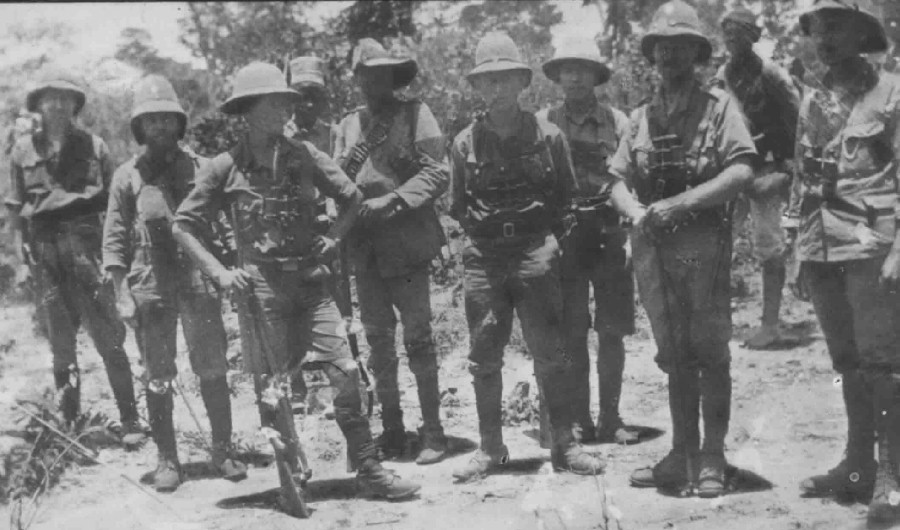
German Officers and NCOs of the 4. Schützenkompanie
Note that the The NCO in the rear centre left is the only man with clear
rank insignia.
Photo by
Dr. Ruppert
©
Frankfurt University Koloniales Bildarchiv
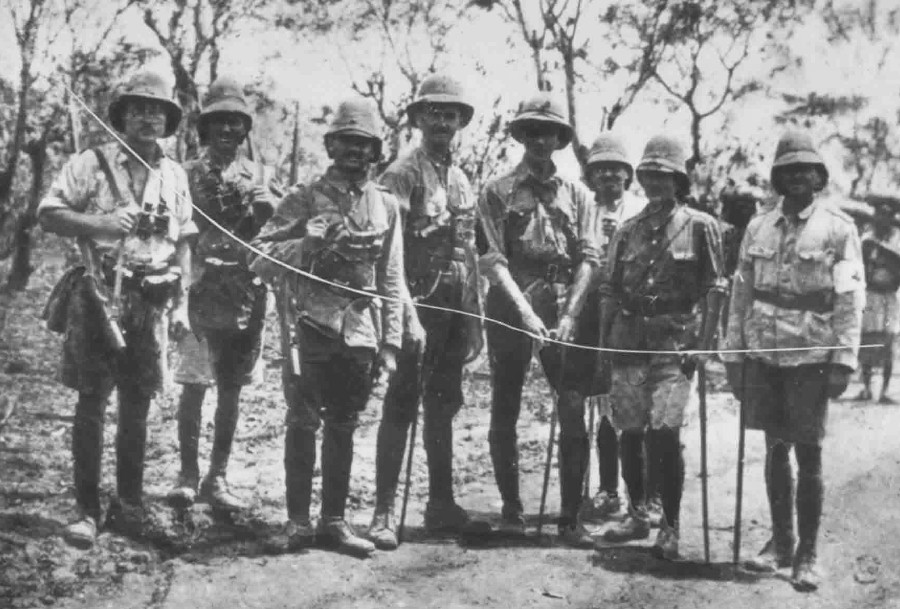
German Officers and NCOs of the 9. Feldkompagnie
Note the clear difference between the lower 1913 tropical helmets
worn by the two taller officers in the centre as compared to the taller
1891 tropical helmets worn by the officers on both sides. The medical
officer on the far right has a red cross brassard.
Photo ©
Frankfurt University Koloniales Bildarchiv
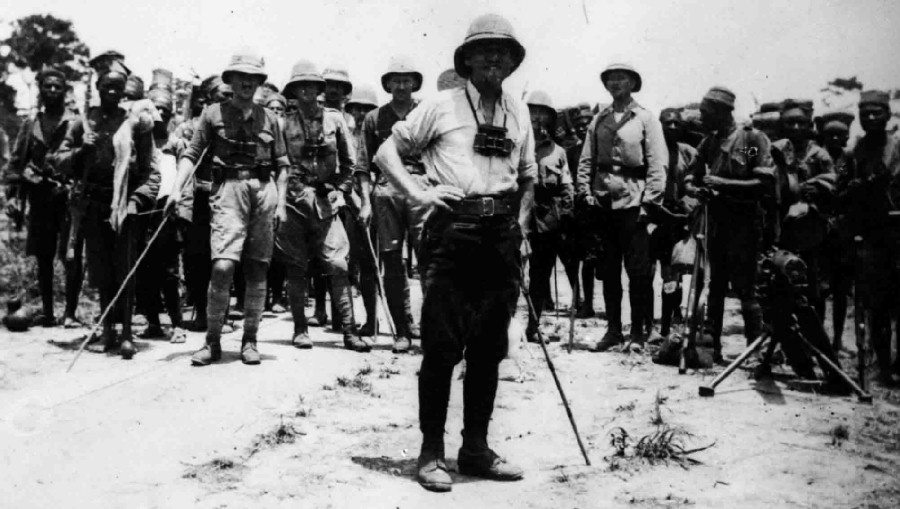
German Officers, NCOs and Askaris
Note the machine gun on a tripod the right side.
Photo ©
Frankfurt University Koloniales Bildarchiv
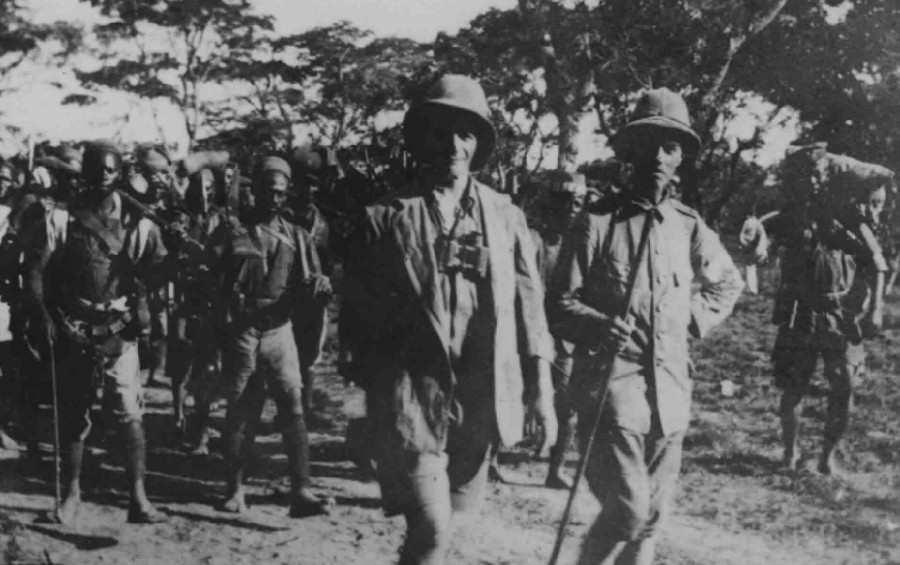
German Officers, NCOs and Askaris on the
march
Photo ©
Frankfurt University Koloniales Bildarchiv
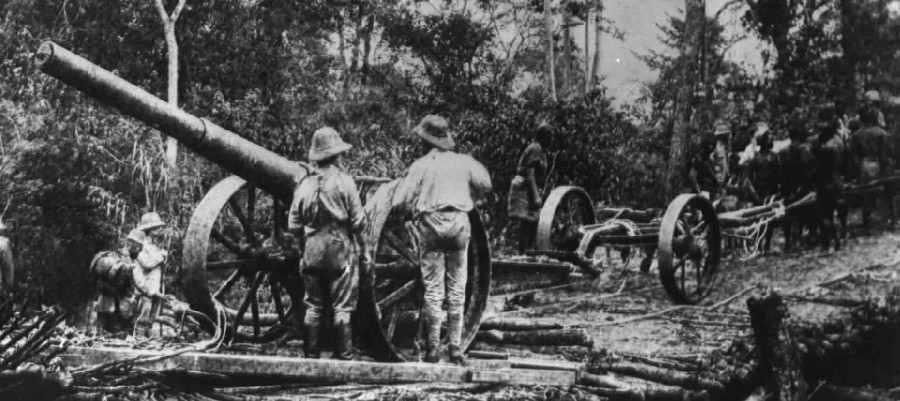
10.5cm Naval Gun on an Improvised Gun Carriage and
Limber with Crew
This salvaged naval gun from the SMS Königsberg is
being dragged across a bridge by a team of African porters
overseen by German officers.
Photo ©
Frankfurt University Koloniales Bildarchiv
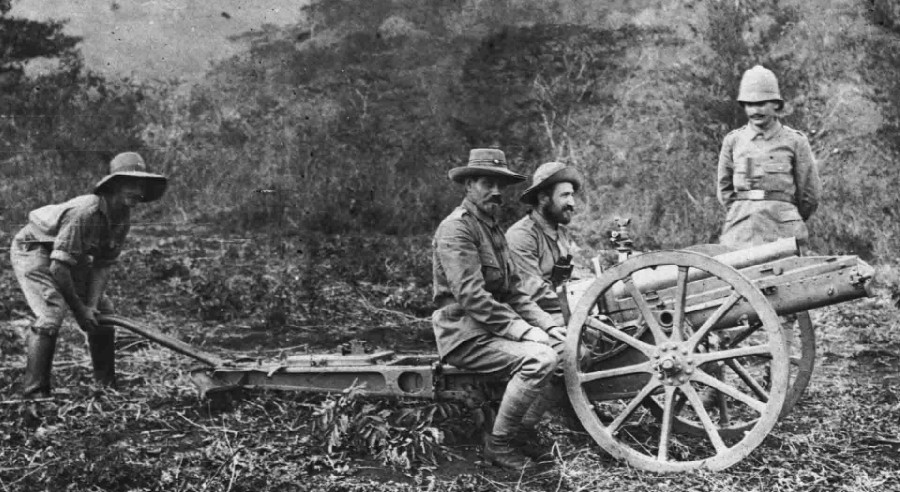
7.5cm Mountain Gun and Crew of the 2. Batterie
This was most likely one of the guns brought to East
Africa by the blockade running SS Marie. Note the different styles of
slouch hat none of which appear to be regulation issue.
Photo by Wilhelm Erhart ©
Frankfurt University Koloniales Bildarchiv
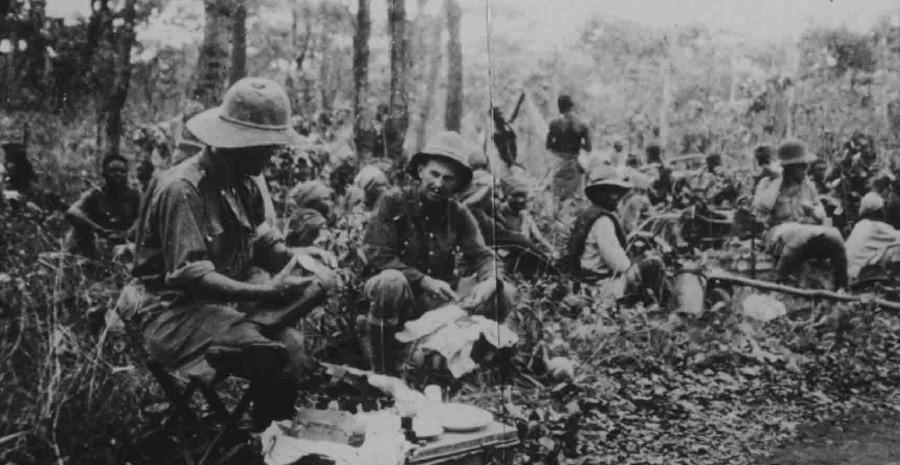
German Officers and Askaris
Making Camp in Portuguese East Africa, 1917
Photo ©
Frankfurt University Koloniales Bildarchiv
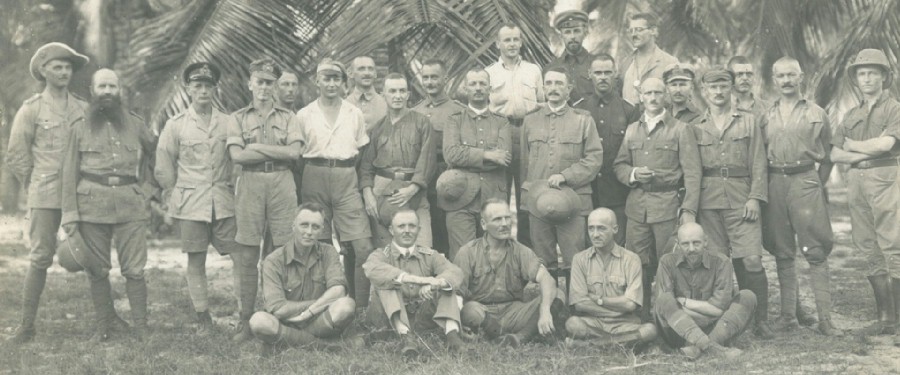
Governor Dr. Schneee with the last German
officers to lay down their arms in November 1918
The mixture of uniforms and headdress can clearly be seen here. Some
have regulation Schutztruppe or specialists' field caps while the
officer on the far left has an issue Südwester slouch hat. Some have
naval officers caps in dark blue or white. Most are bare headed or have
tropical helmets. An interesting point is that none of these officers
wear medals or medal ribbons, although most if not all would have been
entitled to do so. A full list of the last 155 Germans to surrender and
idenfication of these officers can be found at
Traditionsverband.
Photo courtesy of Cobus Boshoff
Main Sources
Photographs from the
Frankfurt University
Colonial Archives and the
Axis History Forum
"Lettow-Vorbeck's Soldiers" by Walther Dobbertin
(Battery Press)
"Armies in East Africa
1914-18" by Peter Abbott, illustrated by Raffaele Ruggeri
(Osprey Men at Arms)
"Colonial
Armies: Africa 1850 to 1918" by Peter
Abbott (Foundry Books)
"The
German Colonial
Troops 1889-1918" by
Jürgen
Kraus and Thomas Müller (Verlag Books)
"Die Deutsche Schutztruppe
1889/1918" by Werner Haupt (Dörfler Publishing)
"Blockade and Jungle" by Nis Kock, edited by
Christen P Christensen (Battery Press)
"My Reminiscences of East Africa" by General Paul von
Lettow-Vorbeck (Battery Press)
See Book Reviews Page
for more on these books and links to order them.
|
